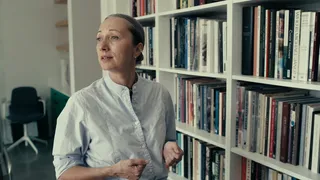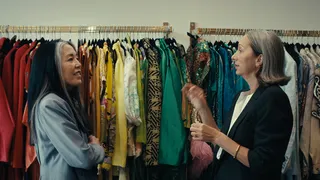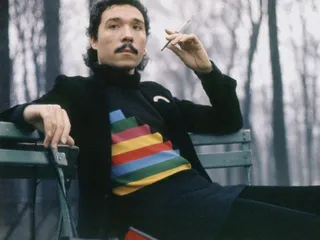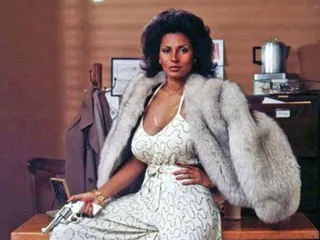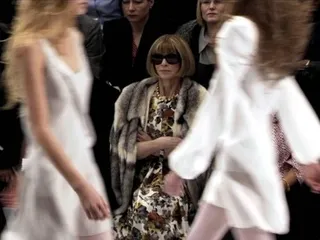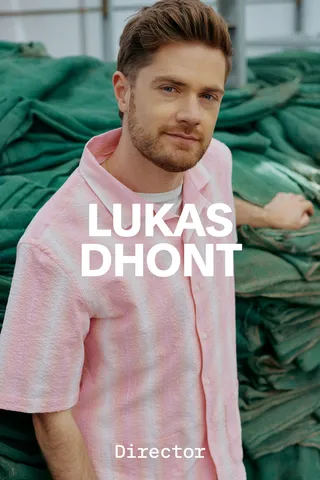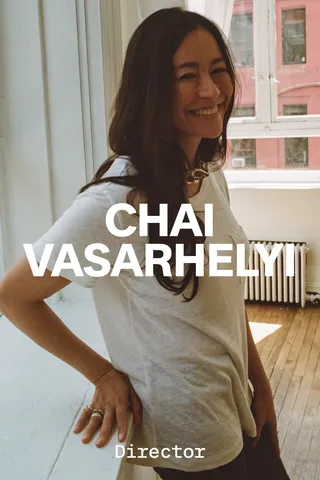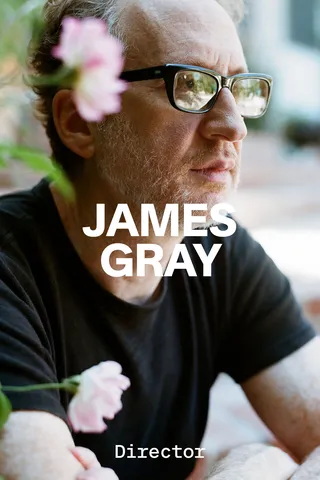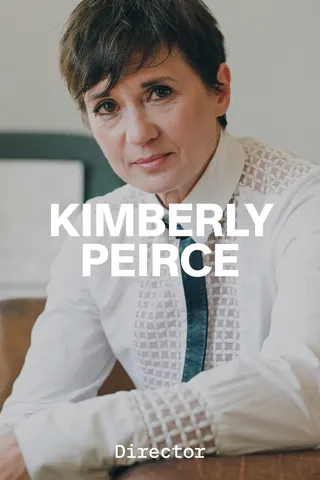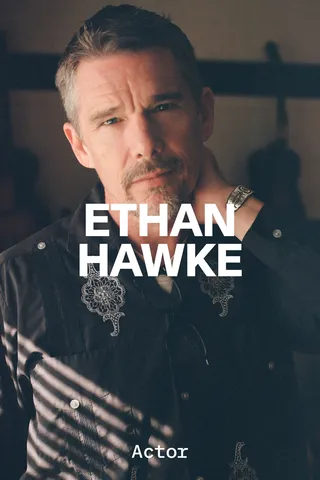Sophie De Rakoff
It comes as no surprise that British-born, U.S.-based costume designer Sophie de Rakoff has a keen eye for a well-dressed movie. The longtime professional ally of Reese Witherspoon has created visually striking looks for some of Hollywood’s biggest screen talent, with projects ranging from the pop (Legally Blonde, Fever Pitch, The Morning Show) to the elevated (editing a behind-the-scenes book about Paul Thomas Anderson’s Phantom Thread). Throughout, de Rakoff’s work reflects her deep love of characters both real and invented, drawing inspiration from art-world photographers like Cindy Sherman and the London street style of her childhood. Her taste for detail, idiosyncrasy and the eccentric manifests in her film curation for Galerie, which includes documentaries and biopics on aesthetic mavericks like Antonio Lopez, Diana Vreeland and Robert Mapplethorpe. She also favors stories with darker undercurrents running beneath stylized surfaces, including Alan J. Pakula’s cryptic thriller Klute (1971), Neil Jordan’s gothic-erotic fantasy The Company of Wolves (1984) and Bruce Robinson’s caustic drama Withnail and I (1987). “When you have an iconic costume and then it enters into the culture, that’s because it’s visual,” says de Rakoff. “You do not have to describe it with words.”
A PERSONAL MESSAGE
my FILM LIST
Click each title to discover our curator’s notes and where to watch
Alan Pakula. Donald Sutherland. Jane Fonda. Gordy Willis. Dark, slow, complicated. The classic of all classic ’70s anti-thrillers, with accolades (including a Best Actress Oscar win for Jane Fonda) up the wazoo. Klute is a fucking great film that continues to live on in the cultural zeitgeist. All hail its costume designer Ann Roth, one of the most beloved and important of costume designers ever in our industry. The macramé bag, the shag haircut, the miniskirts and knee-high boots. Legendary. From Midnight Cowboy to Ma Rainey’s Black Bottom via The Talented Mr. Ripley, the characters Ann Roth has created are deeply woven into the fabric of cinematic and fashion iconography. If you know, you know—and now you can’t unsee it. You’re welcome.
{{ All Items }}An 18th-century Irish rogue, an unreliable narrator, Ryan O’Neal and Marisa Berenson at their most beautiful, and Stanley Kubrick at his most poetic. Soft and opulent, lit with tender light and smoky shadows, Barry Lyndon is a three-hour masterpiece and the prettiest of movies. Costume genius Milena Canonero won her first Oscar for Barry Lyndon.
{{ All Items }}Blaxploitation: noun
“A style of American film, usually cheaply made and not considered to have a high artistic value, that was popular in the 1970s, involved black actors and was intended to attract black audiences.” —Cambridge Dictionary
Friday Foster. One of Pam Grier’s last moments as the reigning Queen of Blaxploitation before she consciously segued into a more dramatic lane. Based on a short-lived comic strip, the film casts Grier as a former model turned photog who gets caught up in all kinds of shenanigans. More intentionally comedic in tone than Grier’s previous movies, this one has some highly enjoyable nuggets to look out for, including: a high-speed chase in a milk truck, excellent neck scarves, a lo-fi runway show, death by big rig, and no sex but an abundance of gratuitous boobs and a very satisfying Eartha Kitt cameo.
{{ All Items }}- A not particularly credible yet highly engaging cult classic that cast Faye Dunaway as a fashion photographer who develops the clairvoyant ability to see through the eyes of a vicious serial killer. One of the most fun things about Eyes of Laura Mars is connecting the dots between the major players who were shaping photography in the 1970s. In the same way that Richard Avedon’s fingerprints are all over Funny Face, Helmut Newton’s iconic kink pervades the visual aesthetic, as does Rebecca Blake’s smudgy erotica, both of whom are credited for the fashion photography depicted in the film. And urban legend has it that Francesco Scavullo shot the iconic poster of—you guessed it—Faye Dunaway’s eyes. Always worth a watch to time-travel back to New York at its grimiest and fashion at its sexiest.
{{ All Items }} This movie needs no introduction. It just needs to be worshipped. Those futuristic visuals and the flying cars and Zhora running in the see-through trench. I fully tried to re-create that later as a baby designer when I made a pink see-through trench for a stripper in a movie called The Center of the World. You realize you pick all these things up and you take them with you. And if, like me, you can’t get enough of all things Blade Runner, here are Sean Young’s behind-the-scenes Polaroids that surfaced a few years ago. Oh, to be the shoebox that housed these beauties.
{{ All Items }}1983. Reagan’s in the White House and Thatcher’s at Downing Street. Punk’s dead, hip-hop is still underground and MTV is on the cusp of changing the world. Enter Adrian Lyne. A young British director with an insatiable appetite for style and gloss, Lyne siphoned pop culture from both sides of the pond and threw it into a blender with a dash of eroticism, a pinch of Fosse and an insane soundtrack. Et voilà! Flashdance. Light on plot but heavy on wish fulfillment, Flashdance gave incoming Gen X teens (aka me) the postfeminist shero they didn’t know they were missing. A racially ambiguous teenage girl who casually bangs the boss and pays the rent on her industrial loft as a welder by day and a stripper by night? Take that, Boomers. Yet all the while dreaming of winning a spot at the local ballet company? Flashdance for the win. A number-one hit and a ripped sweatshirt later, an iconic cinematic lexicon had entered the landscape. But it’s a much bigger story than a cutoff sweatshirt—I’m the MTV generation, and this is what I hoped America would be. It looked and smelled like a music video and was just so glamorous to me. Don’t just take my word for it. Whatever my thoughts are about Flashdance, Karina Longworth thinks it better in her genius podcast You Must Remember This. Flashdance, you complete me.
{{ All Items }}“The worst kind of wolves are hairy on the inside, and when they bite you, they drag you with them to hell.” A gothic fairy tale, a werewolf classic, an infinity mirror of stories within a story, Neil Jordan’s The Company of Wolves was a low-budget British fantasy horror film that elevated the genre to such a level that it is now regarded as a true classic. A maximalist study in brocade and chintz, the costumes designed by Elizabeth Waller dovetailed perfectly into the New Romantic movement in fashion and pop culture that dominated in the early 1980s.
You know that feeling when you’re sweet 16 and you’re singing along to the radio in a fast-moving car with someone you like? That moment of adrenaline and sex and the slow burn of potential? Something Wild is that feeling to me. It’s all there, just bubbling below the surface.
I just fucking loved that movie the first time I saw it. Loved Melanie Griffith, loved Ray Liotta, loved the movie, loved the music, loved the costumes—his cowboy boots, her wig and vintage dress. There’s the scene when she gets in the car and pulls up her skirt and she’s got those hold-up stockings and her legs go on forever. I was like, Who is this woman?
Stop Making Sense. Something Wild. The Silence of the Lambs. Philadelphia. Director Jonathan Demme was (and remains) the man.
{{ All Items }}I have a theory that my people, the British, are not scared to be ugly. They are also funny as fuck. Withnail and I, hilarious and exhausting, supports said thesis. A late-’80s look back at the drug-addled English eccentrics who crawled from the mud in the 1960s, Withnail is a darkly comedic classic, a forever cult movie about friendship and the creeping lure of dissipation.
{{ All Items }}A delightful comedic gem inspired by the kinda-true story of an eccentric con artist who masqueraded around London as Stanley Kubrick during production on Eyes Wide Shut. The perfect vehicle for John Malkovich to indulge his hilarious knack for camp, Color Me Kubrik was directed by Kubrick’s longtime assistant director Brian Cook and written by Kubrick’s researcher and personal assistant, Anthony Frewin. And just to add to the mind-blowing meta of it all, Frewin researched the imposter while his boss was still alive.
{{ All Items }}A lo-fi, intimate documentary about Candy Darling, the most beautiful of all the Warhol superstars and an inspiration for Lou Reed’s “Walk on the Wild Side.” This loving tribute to the transgender actress is grounded in archival footage and interviews with the great thinkers of the countercultural arts scene, with Chloë Sevigny’s narration of Candy’s personal diaries adding another layer of intimacy.
“I wanted to be where the action was.” Diana Vreeland, arguably the greatest of all fashion editors, was the enemy of boring. Like a Mitford sister on acid, she stormed through American fashion for three and a half decades with wit, vision and the sickest personal style. Perfectly edited and beautifully sequenced, The Eye Has to Travel layers interviews, narration and archival footage so stylishly and with such innate chic that perhaps for a nanosecond you can see the world through Mrs. Vreeland’s eyes. When I play the game Ultimate Dinner Party, Mrs. Vreeland is forever at the head of my table, and this doc is the closest I will ever get to knowing what that could feel like.
I love a good movie about movies, a deep dive into the creative process and a first-person account of how shit gets made. If that’s your jam too then what better way to get to know Sidney Lumet than through a film directed by master documentarian Nancy Buirski? Serpico, Dog Day Afternoon, 12 Angry Men, Running on Empty, The Morning After, The Wiz, Network, The Verdict, Equus. So much cinematic iconography packed into one lifetime. Artfully weaving clips from Mr. Lumet’s movies into an unseen interview shot shortly before his death, Buirski leads us through the life and mind of a committed, socially conscious master artist.
When Madonna hit the road with the Blond Ambition tour in 1990, she put together a group of seven male backup dancers to travel the world with her when her fame was at its most intense. In the midst of the devastating HIV crisis, the tour became the focal point for the fight against AIDS, but as with many things Madonna things got complicated quickly. Twenty-five years later Strike a Pose reunited the surviving members of the troupe, allowing them to revisit an era-defining moment in time. All the feels, all the drama—it’s hard not to be moved.
For those who dream in color there is no better bedtime story than the tale of Antonio Lopez, the ferociously talented Nuyorican artist whose personal fabulosity and era-defining illustrations shaped culture at the 1970s intersection of fashion and art. From the Factory to the runways of Paris, director James Crump’s high energy yet delicate embrace of Lopez and his partner Juan Ramos is as much an exploration of a creative partnership as it is a celebration of a beloved individual. Tangled among all the visual delights are a series of wildly satisfying interviews with original Antonio Girl Jessica Lange and legendary New York street photographer Bill Cunningham, who brings a tear to a glass eye with all the feels.
Visit the Antonio Archives and repeat after me: “I do believe in fashion.”
“When you have an iconic costume and then it enters into the culture, that’s because it’s visual. You do not have to describe it with words.”
MY CREATIVE PROCESS
Exploring craft and influence
RELATED MATERIAL
Essays, interviews and other connections
![Antonio Lopez, Resurrected]() Antonio Lopez, Resurrectedread
Antonio Lopez, ResurrectedreadJames Crump’s vital fashion documentary brings the forgotten genius of an industry powerhouse back into the limelight
By Christopher Bollen
![Power Dressing with Pam Grier]() Power Dressing with Pam Grierread
Power Dressing with Pam GrierreadFrom Foxy Brown to Jackie Brown, the dominant glamour of a screen legend
By Cintra Wilson
![Top 10: Derek Blasberg on Fashion Documentaries]() Top 10: Derek Blasberg on Fashion Documentariesread
Top 10: Derek Blasberg on Fashion DocumentariesreadEditor, writer and fashion’s favorite man on the scene breaks down the high-flying art of the style documentary
By Derek Blasberg
